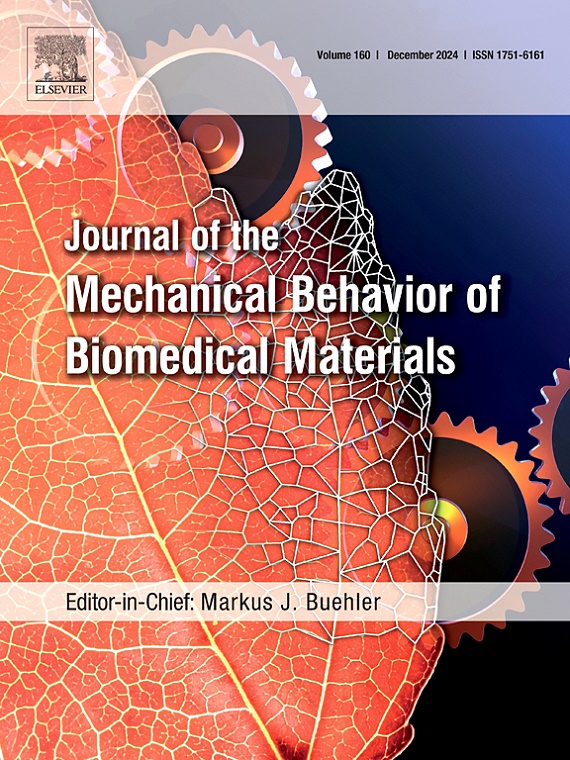Molecular dynamics of complex neuronal cell membrane deformation and failure under different traumatic brain injury scenarios
IF 3.5
2区 医学
Q2 ENGINEERING, BIOMEDICAL
Journal of the Mechanical Behavior of Biomedical Materials
Pub Date : 2025-06-10
DOI:10.1016/j.jmbbm.2025.107099
引用次数: 0
Abstract
Neuronal membrane mechanical deformation and disruption are nanoscale damage mechanisms that critically affect brain cell function and viability during traumatic brain injury (TBI). The nanoscale cellular impairments are elusive in experiments and necessitate computational approaches such as molecular dynamics (MD) simulations. Implementing MD simulations, the current study investigates the mechanical deformation, failure, and mechanoporation damage of complex neuronal membrane systems under different strain rates and strain states in the context of TBI. The obtained results revealed that lower strain rates and more equibiaxial strain states were more detrimental to the neuronal membrane, leading to lower failure strain and higher damage during the mechanoporation process. Lower strain rates resulted in fewer pores with larger sizes, as well as smaller strain and area per lipid at failure. Meanwhile, more equibiaxial strain states exhibited more pores and larger pores, thus higher damage and lower failure strain. Regardless of the strain states it was subjected to, the membrane failed when reaching a critical area per lipid value. Moreover, the Membrane Failure Limit Diagram (MFLD) was updated for a complex multicomponent membrane model to identify the strain limits for potential neuronal membrane failure, aiding in the prediction of TBI-related phenomena. Overall, the study provides a non-invasive approach that progresses the current understanding of neuronal mechanical behavior and damage dynamics under various TBI scenarios, and lays the foundation for future biomedical research in brain injury biomechanics.

不同创伤性脑损伤情景下复杂神经元细胞膜变形与失效的分子动力学
神经元膜的机械变形和破坏是一种纳米级损伤机制,严重影响创伤性脑损伤(TBI)期间脑细胞的功能和活力。纳米尺度的细胞损伤在实验中是难以捉摸的,需要分子动力学(MD)模拟等计算方法。通过MD模拟,本研究研究了在TBI背景下,不同应变速率和应变状态下复杂神经元膜系统的力学变形、破坏和机械操作损伤。结果表明,较低的应变速率和较强的等双轴应变状态对神经元膜的损伤更大,导致机械加工过程中的破坏应变更小,损伤程度更高。较低的应变速率导致更小的孔隙和更大的尺寸,以及更小的应变和每脂的面积。同时,等双轴应变状态越多,孔隙越多,孔隙越大,损伤越大,破坏应变越小。无论它受到的应变状态如何,当达到每个脂质值的临界区域时,膜就失效了。此外,更新了复杂多组分膜模型的膜失效极限图(MFLD),以确定潜在神经元膜失效的应变极限,有助于预测与tbi相关的现象。总的来说,该研究提供了一种非侵入性的方法,促进了目前对各种TBI情景下神经元力学行为和损伤动力学的理解,并为未来脑损伤生物力学的生物医学研究奠定了基础。
本文章由计算机程序翻译,如有差异,请以英文原文为准。
求助全文
约1分钟内获得全文
求助全文
来源期刊

Journal of the Mechanical Behavior of Biomedical Materials
工程技术-材料科学:生物材料
CiteScore
7.20
自引率
7.70%
发文量
505
审稿时长
46 days
期刊介绍:
The Journal of the Mechanical Behavior of Biomedical Materials is concerned with the mechanical deformation, damage and failure under applied forces, of biological material (at the tissue, cellular and molecular levels) and of biomaterials, i.e. those materials which are designed to mimic or replace biological materials.
The primary focus of the journal is the synthesis of materials science, biology, and medical and dental science. Reports of fundamental scientific investigations are welcome, as are articles concerned with the practical application of materials in medical devices. Both experimental and theoretical work is of interest; theoretical papers will normally include comparison of predictions with experimental data, though we recognize that this may not always be appropriate. The journal also publishes technical notes concerned with emerging experimental or theoretical techniques, letters to the editor and, by invitation, review articles and papers describing existing techniques for the benefit of an interdisciplinary readership.
 求助内容:
求助内容: 应助结果提醒方式:
应助结果提醒方式:


